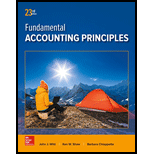
Introduction:
Trend Percentage Analysis
• Trend Percentage Analysis is a technique of performance measurement and evaluation where the performance of the current year is compared to that of a base year and the direction of the results are analyzed.
• The movement of the results can be interpreted as a positive or favorable trend or as a negative or unfavorable trend.
• Favorable trends mean increase in revenues and decrease in costs and are hence subjective in nature. Unfavorable trends mean decrease in revenues and increase in costs and are also subjective in nature.
• Trend analysis helps in evaluation of repetitive behavior as well as evaluation of effectiveness of strategies implemented by allowing analysis of performance over time.
• The following formula is used to calculate trend percentage for each year:
To Determine:
Trend Percents for each year and state if trends are favorable or unfavorable.
Want to see the full answer?
Check out a sample textbook solution
Chapter 17 Solutions
Fundamental Accounting Principles
- Roosevelt Equipment Ltd. manufactures industrial cranes. The standard for a specific crane model calls for 30 direct labor hours at $22 per direct labor hour. During a recent period, 400 cranes were produced. The labor rate variance was zero, and the labor efficiency variance was $8,800 unfavorable. How many actual direct labor hours were worked?arrow_forwardNolan Industries assigns overhead costs to jobs on the basis of 140% of direct labor costs. The job cost sheet for Job 627 includes $31,200 in direct materials cost and $18,500 in direct labor cost. A total of 2,500 units were produced in Job 627. Required: a. What is the total manufacturing cost assigned to Job 627? b. What is the unit product cost for Job 627?arrow_forwardCarlisle Services reported revenues of $78,000, expenses of $72,500, and dividends of $5,800 for the month ended February 28, 2024. Carlisle Services experienced a net income or net loss of what amount?arrow_forward

 AccountingAccountingISBN:9781337272094Author:WARREN, Carl S., Reeve, James M., Duchac, Jonathan E.Publisher:Cengage Learning,
AccountingAccountingISBN:9781337272094Author:WARREN, Carl S., Reeve, James M., Duchac, Jonathan E.Publisher:Cengage Learning, Accounting Information SystemsAccountingISBN:9781337619202Author:Hall, James A.Publisher:Cengage Learning,
Accounting Information SystemsAccountingISBN:9781337619202Author:Hall, James A.Publisher:Cengage Learning, Horngren's Cost Accounting: A Managerial Emphasis...AccountingISBN:9780134475585Author:Srikant M. Datar, Madhav V. RajanPublisher:PEARSON
Horngren's Cost Accounting: A Managerial Emphasis...AccountingISBN:9780134475585Author:Srikant M. Datar, Madhav V. RajanPublisher:PEARSON Intermediate AccountingAccountingISBN:9781259722660Author:J. David Spiceland, Mark W. Nelson, Wayne M ThomasPublisher:McGraw-Hill Education
Intermediate AccountingAccountingISBN:9781259722660Author:J. David Spiceland, Mark W. Nelson, Wayne M ThomasPublisher:McGraw-Hill Education Financial and Managerial AccountingAccountingISBN:9781259726705Author:John J Wild, Ken W. Shaw, Barbara Chiappetta Fundamental Accounting PrinciplesPublisher:McGraw-Hill Education
Financial and Managerial AccountingAccountingISBN:9781259726705Author:John J Wild, Ken W. Shaw, Barbara Chiappetta Fundamental Accounting PrinciplesPublisher:McGraw-Hill Education





